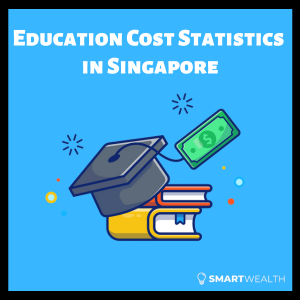Singapore’s education system is taken very seriously, and for good reason. The island nation suffers from a lack of natural resources and thus relies heavily on human capital, seen as one of the keys to its strong economy and high Gross Domestic Product (GDP).
Education in Singapore can be expensive but is seen as necessary.
While Singapore citizens pay heavily subsidised prices, the costs are significantly higher for foreign and international students.
Let’s look at the notable statistics on the cost of education in Singapore.
Note: All figures are in Singapore dollars (SGD).
Top Education Cost Statistics
- The average total cost of education in Singapore is estimated to be $71,409
- Non-citizens (i.e., PRs and foreigners) should expect to pay multiple times the cost borne by citizens
- The average cost of university tuition fees in Singapore is $38,250. Including living costs, the total estimated figure to obtain a university degree is $79,850
- 2 in 3 adults in Singapore think that university education is expensive
- 71.3% of those who consider a university degree expensive still believe that it is worth the cost
- The education inflation rate in Singapore was 2.7% in 2023
- From 2003 to 2023, the cost of education increased by 74.7%
- Over the past 20 years, the average education inflation rate was 2.83% per year
- The projected government expenditure on education for FY2023 is $14.6 billion, representing 14% of total government expenditure
SIDE NOTE When was the last time you conducted thorough financial planning or reviewed your finances? In this day and age in Singapore, doing so will absolutely improve the quality of life for you and your loved ones. Here are 5 reasons why financial planning is so important.
Education Cost Inflation
Education is not immune to inflation. However, the rates at which education inflation takes place do not necessarily match headline or core inflation.
For instance, in 2023, headline inflation was 4.8%. According to the Monetary Authority of Singapore (MAS), headline inflation takes into account consumer prices, including those of key categories of goods and services, accommodation and private road transport.
Meanwhile, core inflation in 2023 was a lower 4.2%. Core inflation takes into account consumer prices in key categories of goods and services but excludes accommodation and private road transport.
By contrast, the education inflation rate in Singapore was just 2.7% in 2023, indicating that the cost of education rose at a slower pace than the general cost of living.
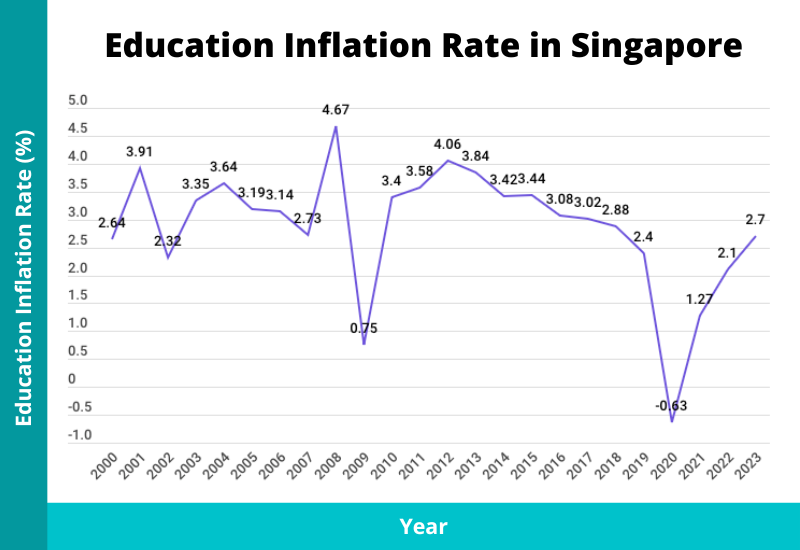
As the above chart shows, the cost of education has risen every year, the only exception being from 2019 to 2020.
From 2003 to 2023, the cost of education increased by a total of 74.7%. The average education inflation rate over the same 20-year period was 2.83% per year.
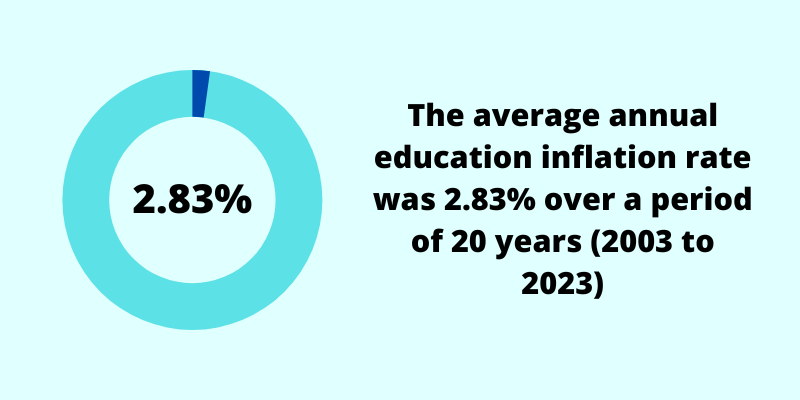
Total Cost of Education
Although school fees are subsidised for Singapore citizens, the total cost of a student’s entire educational journey can still be considerable.
The average total cost of education in Singapore is estimated at $71,409.
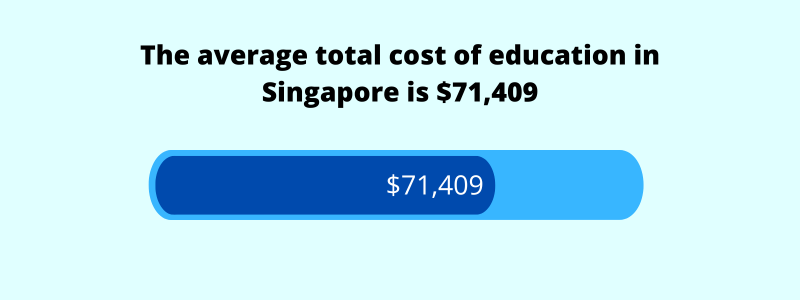
Here is a breakdown of typical costs at the various education levels.
| Education Level | Term | Average Cost |
| Infant Care | 16 months | $10,140.80 |
| Child Care | 66 months | $20,090.40 |
| Primary School | 6 years | $936 |
| Secondary School | 4 years | $1,200 |
| Junior College (JC) | 2 years | $792 |
| Polytechnic | 3 years | $9,000 |
| Institute of Education (ITE) | 3 years | $1,770 |
| University | 4 years | $38,250 |
These estimates assume the following about the child in question:
- The child is a Singapore citizen
- Both of his or her parents are working full-time and have a median household income
- The educational pathway commences in full-day infant care followed by full-day child care
- The child attends only government schools
- The child goes to university by way of Junior College, without enrolling at a polytechnic
- The above figures are not adjusted for inflation and do not take into account the cost of living or the price of miscellaneous items
DID YOU KNOW? According to a survey conducted by MoneySense, about 3 out of 10 Singapore residents aged 30 to 59 had not started planning for their future financial needs. This isn't surprising because personal finance can seem complicated and daunting. But really, there are only a few things that you should focus on. Learn how to significantly improve your personal finances with the 7-step "wedding cake" strategy today.
Cost of University
Singapore’s public universities do fairly well on global university ranking lists, so it comes perhaps as no surprise that university fees, while subsidised for Singapore citizens, are significant.
The average cost of a 4-year general undergraduate university degree is currently $38,250 for Singapore citizens.
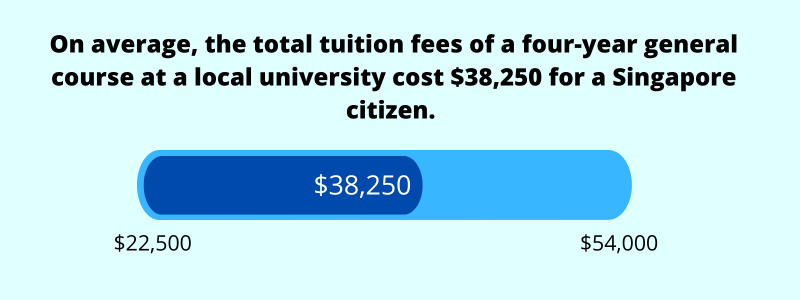
Throughout a child’s educational journey, university fees are likely to be the category contributing most heavily to the overall cost of education. To make matters worse, tuition fees are not the only costs incurred by university students.
According to estimates by the National University of Singapore, the estimated living costs a student will incur over a 4-year university career, excluding tuition fees, add up to $41,600. These estimates take into consideration on-campus accommodation, which costs $2,800 to $5,500 a year.
In total, a student would thus incur $79,850 over the course of a four-year undergraduate degree programme, including tuition fees and living costs. It is possible to lower these costs if the student can live at home with his or her family, however, there might be an opportunity cost of lost rental income for households who would otherwise rent out the student’s room in their absence.
The above estimates are for Singaporean citizen undergraduates attending local public universities. Singaporeans studying overseas can expect to pay much more, with the total cost of an overseas university education easily exceeding $250,000 in countries like the US, Australia and the UK.
What do Singaporeans think? We surveyed 1,088 adults aged 18 and above to gather their thoughts about the cost of university education in Singapore.
According to our survey, 2 in 3 adults in Singapore think that university education is expensive.
However, 71.3% of those who consider a university degree expensive still believe that it is worth the cost.
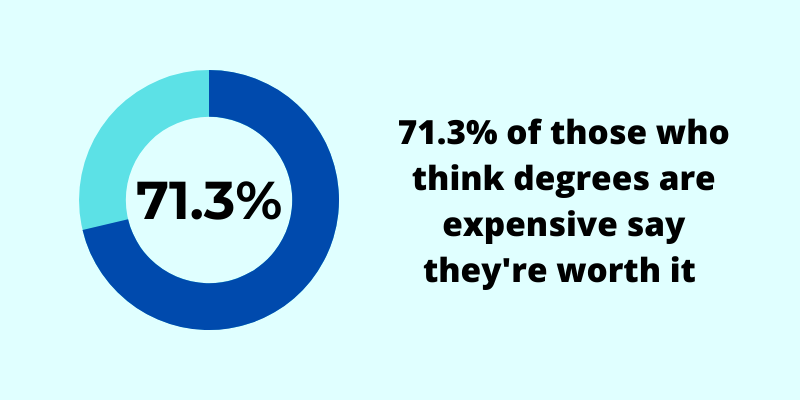
This attitude speaks volumes about the perceived worth of a university education in Singapore, particularly in the job market.
Cost of Education for PRs and Foreigners/International Students
In the case of non-Singapore citizens, residency status has a significant influence on the cost of education. While non-citizens are not entitled to the same heavy government subsidies that Singapore citizens receive, they might still enjoy more modestly subsidised prices depending on their residency status and/or country of origin.
Amongst non-citizens, permanent residents (PRs) pay the lowest education costs.
Amongst those without PR status, international students from the ASEAN region frequently pay lower costs than international students from outside the ASEAN region.
Despite the availability of subsidies in select cases, PRs and foreigners should still be prepared to pay multiple times the cost borne by Singapore citizens.
To illustrate the disparity in costs, the tables below compare the fees paid by Singapore citizens, PRs, and foreigners.
Here are the monthly costs for infant and child care at an ECDA-licensed centre (AOP):
| Education Level | Singapore Citizens (SCs) | Permanent Residents (PRs) | Foreigners |
| Infant Care (Full-Day) | $633.80 | $1,721.20 | $2,065.50 |
| Child Care (Full-Day) | $304.40 | $972 | $1,166.40 |
Note: The fees for Singapore citizens indicated above take into account subsidies received by households earning the median income in which the mother is working.
PRs pay 3 times the cost of what Singapore citizens pay, while foreigners pay about 3.5 times.
Once a child enrols in primary school, PR and foreign households will find themselves paying many times what Singapore citizens pay.
Here are the monthly costs of education from primary school to pre-university level.
| Education Level | Singapore Citizens (SCs) | Permanent Residents (PRs) | Foreigners / International Students (ASEAN) | Foreigners / International Students (non-ASEAN) |
| Primary School | $13 | $268 | $533 | $898 |
| Secondary School | $25 | $520 | $930 | $1,790 |
| Junior College (Pre-University) | $33 | $607 | $1,137 | $2,147 |
As the above table shows, PRs pay approximately 20 times what Singapore citizens pay, while ASEAN and non-ASEAN international students pay 40 and 70 times more respectively. The high costs for international students have possibly been set as a response to international school fees in Singapore.
Finally, the table below indicates the cost of a 4-year general undergraduate degree at a local university.
| Education Level | Singapore Citizens (SCs) | Permanent Residents (PRs) | Foreigners / International Students (Subsidised) | Non-Subsidised Students |
| University (4-year general course) | $38,250 | $61,700 | $95,400 | $151,862 |
At the university level, PRs pay about 61% higher fees than Singapore citizens.
Subsidised international students pay 150% more than Singapore citizens, while non-subsidised students pay 300% more. Most international students are eligible for subsidised fees, however, they must serve a 3-year bond after graduation.
Due to the heavy subsidies at local universities, parents intending to enrol their Singapore citizen children in a private educational institution can generally expect fees to be significantly higher. However, that is not always the case for international students, who might find certain private educational institutions more affordable.
Government Expenditure/Spending on Education
The projected government expenditure on education for FY2023 is $14.6 billion, according to Budget 2023. This is the 3rd largest budget allocation behind defence ($17.98 billion) and healthcare ($16.88 billion), and it represents 14% of the estimated total government expenditure ($104.2 billion).
But how much has the government spent on education in the past?
In FY2022, the total government spending on education was $13.2 billion, which consisted of recurrent and development expenditures. This was an increase of 2.61% from FY2021 ($12.9 billion).
| 2022 | 2021 | 2020 | 2019 | 2018 | 2017 | 2016 | 2015 | 2014 | 2013 | 2012 | |
| Total Government Expenditure On Education (Thousand Dollars) | 13,247,000 | 12,909,908 | 12,259,853 | 12,723,276 | 12,875,992 | 12,690,630 | 12,468,854 | 11,934,956 | 11,598,458 | 11,638,313 | 10,496,911 |
| Proportion Of Government Expenditure On Education To GDP (Per Cent) | na | 2.2 | 2.5 | 2.5 | 2.5 | 2.6 | 2.8 | 2.8 | 2.9 | 3 | 2.8 |
While the proportion of government expenditure on education to GDP isn’t available for FY2022 yet, it was 2.2% in FY2021.
Below is how much the government spends on education per student, based on various education levels:
| FY2022 | |
| Primary Schools | $13,345 |
| Secondary Schools | $17,001 |
| Junior Colleges | $18,396 |
| Full-Time NITEC/ Higher NITEC Courses | $15,643 |
| Publicly-Funded Full-Time Diploma Courses | $17,618 |
| Publicly-Funded Full-Time Degree Courses | $21,065 |
Wrapping Up
Education is still important in Singapore.
While there may be outliers, based on statistics, degree holders earn higher salaries.
Although the entire journey to obtain a degree can amount to a tidy sum of money, it’s still a conservative approach to financial well-being.
In time to come, the introduction of more non-traditional ways of earning an income (e.g., digital content creation) could shift this entire landscape. But, for now, education remains very relevant.
